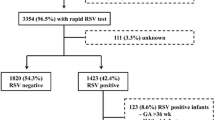Abstract
Background
To investigate the clinical characteristics and analyze risk factors for severe respiratory syncytial virus (RSV) infection in hospitalized infants with acute lower respiratory tract infections (ALRIs).
Methods
A retrospective review of the medical records of infants with RSV-associated ALRIs between March 1st, 2011 and February 29th, 2012 was conducted. Subjects were followed up over the phone or by outpatient visit six and twelve months after discharge.
Results
Among 913 RSV-associated ALRIs infants, 288 (31.5%) had severe infections, which accounted for 4.2% of hospitalized children. The hospital RSV mortality rate was 1.0%. The proportions of cases with tachypnea, apnea, cyanosis, and fine rales were significantly higher in the severe ALRIs group (all P<0.001). Multivariate logistic regression showed that low-birth-weight [1.698 (1.028–2.805)], age less than 3 months old [3.385 (2.174–5.271)], congenital heart disease [1.667 (1.149–2.418)], bronchopulmonary dysplasia [8.505 (1.731–41.780)], and airway abnormalities [2.246 (1.008–5.005)] were independent risk factors for severe ALRIs. The incidence of bronchitis, pneumonia and readmission in the severe group was significantly higher than that of the non-severe group during the one-year follow-up (all P<0.001).
Conclusions
Younger age, low birth weight and underlying disease are associated with severe RSVassociated ALRIs. Furthermore, severe RSV infections may be associated with a higher frequency of subsequent bronchitis, pneumonia and re-hospitalization in the following year.
Similar content being viewed by others
References
Nair H, Nokes DJ, Gessner BD, Dherani M, Madhi SA, Singleton RJ, et al. Global burden of acute lower respiratory infections due to respiratory syncytial virus in young children: a systematic review and meta-analysis. Lancet 2010;375:1545–1555.
Morris SK, Dzolganovski B, Beyene J, Sung L. A meta-analysis of the effect of antibody therapy for the prevention of severe respiratory syncytial virus infection. BMC Infect Dis 2009;9:106.
Resch B. Respiratory syncytial virus infection in high-risk infants — an update on palivizumab prophylaxis. Open Microbiol J 2014;11:71–77.
Kong X, Liu C, Shou H, Shen K, Mai Y, Wang S, et al. Correlation between illness severity and risk factors for respiratory syncytial virus infection. Chin J Pediatr 2000;38:603–606.
Hon KL, Leung TF, Cheng WY, Ko NMW, Tang WK, Wong WW, et al. Respiratory syncytial virus morbidity, premorbid factors, seasonality, and implications for prophylaxis. J Crit Care 2012;27:464–468.
Leung T, Lam D, Miu T, Hon K, Chau C, Ku S, et al. Epidemiology and risk factors for severe respiratory syncytial virus infections requiring pediatric intensive care admission in Hong Kong children. Infection 2014;42:343–350.
Zhang T, Zhu Q, Zhang X, Ding Y, Steinhoff M, Black S, et al. Clinical characteristics and direct medical cost of respiratory syncytial virus infection in children hospitalized in Suzhou, China. Pediatr Infect Dis J 2014;33:337–341.
Oncel MY, Arayici S, Simsek GK, Calisici E, Erdeve O, Uras N, et al. Risk factors for hospitalization due to lower respiratory tract infection in preterm infants on palivizumab prophylaxis. Iran J Pediatr 2013;23:693–700.
Piedimonte G. Respiratory syncytial virus and asthma: speeddating or long-term relationship? Curr Opin Pediatr 2013;25:344–349.
Hu Y, Jiang Z. Practical Pediatric Textbook of Fu-tang Zhu, 7th ed. Beijing: People’s Hygiene Publishing, 2005.
Subspecialty Group of Respiratory Diseases, Society of Pediatrics, Chinese Medical Association; Editorial Board, Chinese Journal of Pediatrics. Guidelines for management of childhood community acquired pneumonia (for trial implementation). Chin J Pediatr (Chin) 2007;45:83–90.
McConnochie KM, Hall CB, Walsh EE, Roghmann KJ. Variation in severity of respiratory syncytial virus infections with subtype. J Pediatr 1990;117:52–62.
Jansen AG, Sanders EA, Hoes AW, Van Loon A, Hak E. Influenza-and respiratory syncytial virus-associated mortality and hospitalisations. Eur Respir J 2007;30:1158–1166.
Singleton RJ, Bruden D, Bulkow LR. Respiratory syncytial virus season and hospitalizations in the Alaskan Yukon-Kuskokwim Delta. Pediatr Infect Dis J 2007;26:S46–S50.
Thorburn K. Pre-existing disease is associated with a significantly higher risk of death in severe respiratory syncytial virus infection. Arch Dis Child 2009;94:99–103.
Ito H, Osamura T, Nakajima F, Fujiwara D, Kuwabara Y, Yamamoto T, et al. Survey of severe respiratory syncytial virus infection in Kyoto Prefecture from 2003 to 2007. Pediatr Int 2010;52:273–278.
Grimwood K, Cohet C, Rich F, Cheng S, Wood C, Redshaw N, et al. Risk factors for respiratory syncytial virus bronchiolitis hospital admission in New Zealand. Epidemiol Infect 2008;136:1333–1341.
Castro-Rodríguez JA, Holberg CJ, Wright AL, Halonen M, Taussig LM, Morgan WJ, et al. Association of radiologically ascertained pneumonia before age 3 yr with asthmalike symptoms and pulmonary function during childhood: a prospective study. Am J Respir Crit Care Med 1999;159:1891–1897.
Kusel MM, de Klerk NH, Kebadze T, Vohma V, Holt PG, Johnston SL, et al. Early-life respiratory viral infections, atopic sensitization, and risk of subsequent development of persistent asthma. J Allergy Clin Immunol 2007;119:1105–1110.
Eriksson M, Bennet R, Nilsson A. Wheezing following lower respiratory tract infections with respiratory syncytial virus and influenza A in infancy. Pediatr Allergy Immunol 2000;11:193–197.
Stevens TP, Sinkin RA, Hall CB, Maniscalco WM, McConnochie KM. Respiratory syncytial virus and premature infants born at 32 weeks’ gestation or earlier: hospitalization and economic implications of prophylaxis. Arch Pediatr Adolesc Med 2000;154:55–61.
Carbonell-Estrany X, Quero J, Bustos G, Cotero A, Domenech E, Figueras-Aloy J, et al. Rehospitalization because of respiratory syncytial virus infection in premature infants younger than 33 weeks of gestation: a prospective study. IRIS Study Group. Pediatr Infect Dis J 2000;19:592–597.
Author information
Authors and Affiliations
Corresponding author
Rights and permissions
About this article
Cite this article
Zhang, XB., Liu, LJ., Qian, LL. et al. Clinical characteristics and risk factors of severe respiratory syncytial virus-associated acute lower respiratory tract infections in hospitalized infants. World J Pediatr 10, 360–364 (2014). https://doi.org/10.1007/s12519-014-0513-x
Received:
Accepted:
Published:
Issue Date:
DOI: https://doi.org/10.1007/s12519-014-0513-x




